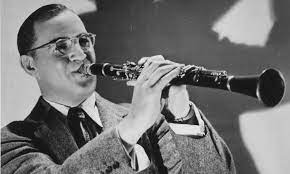Benny Goodman, born Benjamin David Goodman on May 30, 1909, in Chicago, Illinois, was a pioneering American clarinetist and bandleader whose impact on jazz and swing music is immeasurable. From humble beginnings to international acclaim, Goodman’s journey epitomizes the evolution of jazz in the 20th century.
Raised in a poor Jewish neighborhood on Chicago’s West Side, Goodman was exposed to music at an early age. His father, a tailor, encouraged Benny and his eleven siblings to pursue musical education. Goodman began his musical training on the clarinet at the age of 10 and quickly displayed prodigious talent.
In his teenage years, Goodman played in various bands around Chicago, mastering the intricacies of jazz and developing his distinctive clarinet style influenced by the likes of Louis Armstrong and Jimmie Noone. In 1926, he left Chicago to join Ben Pollack’s band, where he gained valuable experience and recognition.
Goodman’s breakthrough came in the late 1930s when he formed his own band and became the “King of Swing.” His orchestra, featuring legendary musicians such as Teddy Wilson, Lionel Hampton, and Gene Krupa, achieved unprecedented success. They captivated audiences with their tight arrangements, infectious rhythms, and Goodman’s virtuosic clarinet solos.
In 1935, Goodman and his band made history with their performance at the Palomar Ballroom in Los Angeles, where they ignited the swing craze and solidified Goodman’s status as a cultural icon. The event marked a turning point in American music, ushering in the swing era and propelling jazz into the mainstream.
Throughout the 1930s and 1940s, Goodman’s orchestra dominated the airwaves, recording numerous hit singles and albums. Their renditions of classics like “Sing, Sing, Sing” and “Stompin’ at the Savoy” remain timeless standards of the swing era.
Goodman’s contributions to music extended beyond his performances as a bandleader. He broke racial barriers by integrating his band with African American musicians, including pianist Teddy Wilson and vibraphonist Lionel Hampton, at a time when segregation was still prevalent in America.
Despite his monumental success, Goodman was known for his perfectionism and demanding demeanor, earning him the nickname “The Professor.” However, his dedication to his craft and uncompromising standards elevated the quality of jazz and inspired generations of musicians.
In later years, Goodman continued to perform, record, and collaborate with esteemed artists from various genres. He received numerous accolades, including multiple Grammy Awards and a Lifetime Achievement Award from the National Academy of Recording Arts and Sciences.
Benny Goodman’s legacy endures as a towering figure in the history of jazz. His innovative spirit, technical mastery, and relentless pursuit of excellence continue to inspire musicians and audiences around the world, ensuring his place among the greatest musicians of all time. Benny Goodman passed away on June 13, 1986, leaving behind a rich musical legacy that continues to resonate to this day.


No responses yet